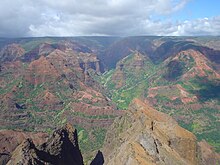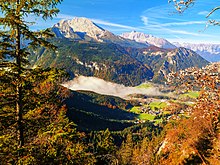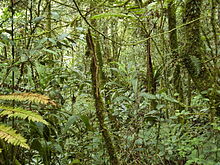Montane ecosystems

Montane ecosystemsare found on the slopes ofmountains.Thealpine climatein these regions strongly affects theecosystembecause temperaturesfall as elevation increases,causing the ecosystem to stratify. This stratification is a crucial factor in shaping plant community, biodiversity, metabolic processes and ecosystem dynamics for montane ecosystems.[1]Dense montaneforestsare common at moderate elevations, due to moderate temperatures and high rainfall. At higher elevations, the climate is harsher, with lower temperatures and higher winds, preventing the growth of trees and causing the plant community to transition tomontane grasslands and shrublandsoralpine tundra.Due to the unique climate conditions of montane ecosystems, they contain increased numbers of endemic species. Montane ecosystems also exhibit variation inecosystem services,which include carbon storage and water supply.[2]
Life zones
[edit]
As elevation increases, theclimate becomes cooler,due to a decrease inatmospheric pressureand theadiabatic coolingof airmasses.[3]Inmiddle latitudes,the change in climate by moving up 100 meters on a mountain is roughly equivalent to moving 80 kilometers (45 miles or 0.75° oflatitude) towards the nearest pole.[4]The characteristic flora and fauna in the mountains tend to strongly depend on elevation, because of the change in climate. This dependency causeslife zonesto form: bands of similar ecosystems at similar elevations.[5]
One of the typical life zones on mountains is the montane forest: at moderate elevations, the rainfall and temperate climate encourages dense forests to grow.Holdridgedefines the climate of montane forest as having a biotemperature of between 6 and 12 °C (43 and 54 °F), where biotemperature is the mean temperature considering temperatures below 0 °C (32 °F) to be 0 °C (32 °F).[5]Above the elevation of the montane forest, the trees thin out in the subalpine zone, become twistedkrummholz,and eventually fail to grow. Therefore, montane forests often contain trees with twisted trunks. This phenomenon is observed due to the increase in the wind strength with the elevation. The elevation where trees fail to grow is called thetree line.The biotemperature of the subalpine zone is between 3 and 6 °C (37 and 43 °F).[5]
Above the tree line the ecosystem is called the alpine zone oralpine tundra,dominated by grasses and low-growing shrubs. The biotemperature of the alpine zone is between 1.5 and 3 °C (34.7 and 37.4 °F). Many different plant species live in the alpine environment, includingperennial grasses,sedges,forbs,cushion plants,mosses,andlichens.[6]Alpine plants must adapt to the harsh conditions of the alpine environment, which include low temperatures, dryness, ultraviolet radiation, and a short growing season. Alpine plants display adaptations such as rosette structures, waxy surfaces, and hairy leaves. Because of the common characteristics of these zones, theWorld Wildlife Fundgroups a set of relatedecoregionsinto the "montane grassland and shrubland"biome. A region in theHengduan Mountainsadjoining Asia's Tibetan Plateau have been identified as the world's oldest continuous alpine ecosystem with a community of 3000 plant species, some of them continuously co-existing for 30 million years.[7]
Climates with biotemperatures below 1.5 °C (35 °F) tend to consist purely of rock and ice.[5]
Montane forests
[edit]
Montane forests occur between thesubmontane zoneand thesubalpine zone.The elevation at which one habitat changes to another varies across the globe, particularly bylatitude.The upper limit of montane forests, thetree line,is often marked by a change to hardier species that occur in less dense stands.[8]For example, in theSierra NevadaofCalifornia,the montane forest has dense stands oflodgepole pineandred fir,while theSierra Nevada subalpine zonecontains sparse stands ofwhitebark pine.[9]
The lower bound of the montane zone may be a "lower timberline" that separates the montane forest from driersteppeordesertregion.[8]
Montane forests differ from lowland forests in the same area.[10]The climate of montane forests is colder than lowland climate at the same latitude, so the montane forests often have species typical of higher-latitude lowland forests.[11]Humans can disturb montane forests throughforestryandagriculture.[10]On isolated mountains, montane forests surrounded by treeless dry regions are typical "sky island"ecosystems.[12]
Temperate climate
[edit]Montane forests in temperate climate are typically one oftemperate coniferous forestortemperate broadleaf and mixed forest,forest types that are well known fromEuropeand northeasternNorth America.Montane forests outside Europe tend to be more species-rich, because Europe during the Pleistocene offered smaller-area refugia from the glaciers.[13]

Montane forests in temperate climate occur in Europe (theAlps,Carpathians,andmore),[14]inNorth America(e.g.,Appalachians,Rocky Mountains,Cascade Range,andSierra Nevada),[15]South America,[16]New Zealand,[17]and theHimalayas.
Climate change is predicted to affect temperate montane forests. For example, in thePacific Northwestof North America, climate change may cause "potential reduced snowpack, higher levels of evapotranspiration, increased summer drought" which will negatively affect montane wetlands.[18]
Mediterranean climate
[edit]
Montane forests inMediterranean climateare warm and dry except in winter, when they are relatively wet and mild. Montane forests located in Mediterranean climates, known as oro-Mediterranean, exhibit towering trees alongside high biomass.[19]These forests are typically mixed conifer and broadleaf forests, with only a few conifer species.Pineandjuniperare typical trees found in Mediterranean montane forests. The broadleaf trees show more variety and are often evergreen, e.g.evergreen oak.[citation needed]
This type of forest is found in theMediterranean Basin,North Africa,Mexicoand thesouthwestern US,Iran,PakistanandAfghanistan.[citation needed]
Subtropical and tropical climate
[edit]
In the tropics, montane forests can consist ofbroadleaf forestin addition toconiferous forest.One example of a tropical montane forest is acloud forest,which gains its moisture from clouds and fog.[20][21][22]Cloud forests often exhibit an abundance ofmossescovering the ground and vegetation, in which case they are also referred to as mossy forests. Mossy forests usually develop on thesaddlesof mountains, where moisture introduced by settling clouds is more effectively retained.[23]Depending on latitude, the lower limit of montane rainforests on large mountains is generally between 1,500 and 2,500 metres (4,900 and 8,200 ft) while the upper limit is usually from 2,400 to 3,300 metres (7,900 to 10,800 ft).[24]
Tropical montane forests might exhibit high sensitivity to climate change.[25][26]Climate change may cause variation in temperature, precipitation and humidity, which will cause stress on tropical montane forests. The predicted upcoming impacts of climate change might significantly affectbiodiversity lossand might result in change of species range and community dynamics.Global climate modelspredict reduced cloudiness in the future. Reduction in cloudiness may already be affecting theMonteverde cloud forestinCosta Rica.[27][28]
Subalpine zone
[edit]The subalpine zone is thebiotic zoneimmediately below thetree linearound the world. In tropical regions ofSoutheast Asiathe tree line may be above 4,000 m (13,000 ft),[29]whereas in Scotland it may be as low as 450 m (1,480 ft).[30]Species that occur in this zone depend on the location of the zone on the Earth; for example,Pinus mugo(scrub mountain pine) occurs inEurope,[31]thesnow gumis found in Australia,[32]and thesubalpine larch,mountain hemlock,andsubalpine firoccur in western North America.[33]

Trees in the subalpine zone often becomekrummholz,that is, crooked wood, stunted and twisted in form. At tree line, tree seedlings may germinate on thelee sideof rocks and grow only as high as the rock provides wind protection. Further growth is more horizontal than vertical, and additional rooting may occur where branches contact the soil. Snow cover may protect krummholz trees during the winter, but branches higher than wind-shelters or snow cover are usually destroyed. Well-established krummholz trees may be several hundred to a thousand years old.[34]
Meadowsmay be found in the subalpine zone.Tuolumne Meadowsin theSierra NevadaofCalifornia,is an example of a subalpine meadow.[35]
Example subalpine zones around the world include theFrench Prealpsin Europe, theSierra NevadaandRocky Mountainsubalpine zones in North America, and subalpine forests in theeastern Himalaya,western Himalaya,andHengduan mountainsof Asia.
Alpine grasslands and tundra
[edit]
Alpine grasslands and tundra lie above the tree line, in a world of intense radiation, wind, cold, snow, and ice. As a consequence, alpine vegetation is close to the ground and consists mainly ofperennial grasses,sedges,andforbs.Annual plants are rare in this ecosystem and usually are only a few inches tall, with weak root systems.[36]Other commonplant life-formsincludeprostrate shrubs;tussock-forminggraminoids;andcryptogams,such asbryophytesandlichens.[6]: 280
Plants have adapted to the harsh alpine environment.Cushion plants,looking like ground-hugging clumps of moss, escape the strong winds blowing a few inches above them. Many flowering plants of the alpine tundra have dense hairs on stems and leaves to provide wind protection orred-colored pigmentscapable of converting the sun's light rays into heat. Some plants take two or more years to form flower buds, which survive the winter below the surface and then open and produce fruit with seeds in the few weeks of summer.[37]Non-floweringlichenscling to rocks and soil. Their enclosedalgal cellscanphotosynthesizeat temperatures as low as −10 °C (14 °F),[38]and the outer fungal layers can absorb more than their own weight in water.[39]

The adaptations for survival of drying winds and cold may make tundra vegetation seem very hardy, but in some respects the tundra is very fragile. Repeated footsteps often destroy tundra plants, leaving exposed soil to blow away, and recovery may take hundreds of years.[37]
Alpine meadows form where sediments from the weathering of rocks has produced soils well-developed enough to support grasses and sedges. Alpine grasslands are common enough around the world to be categorized as abiomeby theWorld Wildlife Fund.The biome, called "Montane grasslands and shrublands",often evolved as virtual islands, separated from other montane regions by warmer, lower elevation regions, and are frequently home to many distinctive andendemicplants which evolved in response to the cool, wetclimateand abundant sunlight.[citation needed]

The most extensive montane grasslands and shrublands occur in theNeotropicalpáramoof theAndes Mountains.This biome also occurs in the mountains ofeastandcentral Africa,Mount KinabaluofBorneo,the highest elevations of theWestern Ghatsin South India and the Central Highlands ofNew Guinea.A unique feature of many wet tropical montane regions is the presence of giant rosette plants from a variety of plant families, such asLobelia(Afrotropic),Puya(Neotropic),Cyathea(New Guinea), andArgyroxiphium(Hawaii).[citation needed]
Where conditions are drier, one finds montane grasslands, savannas, and woodlands, like theEthiopian Highlands,and montanesteppes,like the steppes of theTibetan Plateau.[citation needed]
See also
[edit]- Forest ecology
- Tree line
- Temperate coniferous forests
- Ecology of the Rocky Mountains
- Sierra Nevada lower montane forest
- East African montane forests
- Afromontane,a series of high-elevation regions in Africa
- California montane chaparral and woodlands,an ecoregion.
- Angolan montane forest-grassland mosaic,an ecoregion.
- Australian Alps montane grasslands,an ecoregion.
- South Western Ghats montane rain forests,an ecoregion
- Polonyna (montane meadow)
- Altitudinal zonation
- Biome
References
[edit]- ^Mayor, Jordan R.; Sanders, Nathan J.; Classen, Aimée T.; Bardgett, Richard D.; Clément, Jean-Christophe; Fajardo, Alex; Lavorel, Sandra; Sundqvist, Maja K.; Bahn, Michael; Chisholm, Chelsea; Cieraad, Ellen (February 2017)."Elevation alters ecosystem properties across temperate tree lines globally".Nature.542(7639): 91–95.Bibcode:2017Natur.542...91M.doi:10.1038/nature21027.hdl:1874/394068.ISSN1476-4687.PMID28117440.S2CID4455333.
- ^Aparecido, Luiza Maria T.; Teodoro, Gazelle S.; Mosquera, Giovanny; Brum, Mauro; Barros, Fernanda de V.; Pompeu, Patricia Vieira; Rodas, Melissa; Lazo, Patricio; Müller, Caroline S.; Mulligan, Mark; Asbjornsen, Heidi (2018)."Ecohydrological drivers of Neotropical vegetation in montane ecosystems".Ecohydrology.11(3): e1932.Bibcode:2018Ecohy..11E1932A.doi:10.1002/eco.1932.ISSN1936-0592.S2CID134197371.
- ^Goody, Richard M.; Walker, James C.G. (1972)."Atmospheric Temperatures"(PDF).Atmospheres.Prentice-Hall.Archived(PDF)from the original on 29 July 2016.
- ^Blyth, S.; Groombridge, B.; Lysenko, I.; Miles, L.; Newton, A. (2002)."Mountain Watch"(PDF).UNEP World Conservation Monitoring Centre, Cambridge, UK. p. 15. Archived fromthe original(PDF)on 11 May 2008.
- ^abcdLugo, Ariel E.; Brown, Sandra L.; Dodson, Rusty; Smith, Tom S.; Shugart, Hank H. (1999)."The Holdridge Life Zones of the conterminous United States in relation to ecosystem mapping"(PDF).Journal of Biogeography.26(5): 1025–1038.Bibcode:1999JBiog..26.1025L.doi:10.1046/j.1365-2699.1999.00329.x.S2CID11733879.
- ^abKörner, Christian (2013).Alpine Plant Life: Functional Plant Ecology of High Mountain Ecosystems.Berlin: Springer.ISBN9783642980183.
- ^Stokstad, Erik (30 July 2020)."Many beloved garden flowers originated in this mountain hot spot—the oldest of its kind on Earth".Science | AAAS.Retrieved1 August2020.
- ^abPrice, Larry W. (1986).Mountains and Man: A Study of Process and Environment.University of California Press. p.271.ISBN9780520058866.Retrieved9 March2012.
- ^Rundel, P.W.; D. J. Parsons; D. T. Gordon (1977). "Montane and subalpine vegetation of the Sierra Nevada and Cascade Ranges". InBarbour,M.G.; Major, J. (eds.).Terrestrial vegetation of California.New York, USA: Wiley. pp. 559–599.
- ^abNagy, László; Grabherr, Georg (2009).The biology of alpine habitats.Oxford University Press.
- ^Perry, David A. (1994).Forest Ecosystems.JHU Press. p.49.ISBN0-8018-4987-X.Retrieved9 March2012.
- ^Albert, James S.; Reis, Roberto E. (2011).Historical Biogeography of Neotropical Freshwater Fishes.University of California Press. p. 311.ISBN978-0-520-26868-5.Retrieved9 March2012.
- ^Huntley, Brian (1993). "Species-Richness in North-Temperate Zone Forests".Journal of Biogeography.20(2): 163–180.Bibcode:1993JBiog..20..163H.doi:10.2307/2845669.JSTOR2845669.
- ^"European-Mediterranean Montane Mixed Forests".World Wildlife Fund.Archived fromthe originalon 15 February 2006.
- ^Billings, WD (1990). "The Mountain Forests of North America and Their Environments".Plant Biology of the Basin and Range.Ecological Studies. Vol. 80. Berlin, Heidelberg: Springer. pp. 47–86.doi:10.1007/978-3-642-74799-1_3.ISBN978-3-642-74801-1.
- ^Nagy, L; et al. (2023)."South American mountain ecosystems and global change – a case study for integrating theory and field observations for land surface modelling and ecosystem management".Plant Ecology & Diversity.16(1–2): 1–27.Bibcode:2023PlEcD..16....1N.doi:10.1080/17550874.2023.2196966.
- ^Dawson, John.Forest Vines to Snow Tussocks: The Story of New Zealand Plants.Wellington: Victoria University Press.
- ^Lee, Se-Yeun; Ryan, Maureen E.; Hamlet, Alan F.; Palen, Wendy J.; Lawler, Joshua J.; Halabisky, Meghan (2 September 2015)."Projecting the Hydrologic Impacts of Climate Change on Montane Wetlands".PLOS ONE.10(9): e0136385.Bibcode:2015PLoSO..1036385L.doi:10.1371/journal.pone.0136385.ISSN1932-6203.PMC4557981.PMID26331850.
- ^Kelly, Anne E; Goulden, Michael L (April 2016)."A montane Mediterranean climate supports year-round photosynthesis and high forest biomass".Tree Physiology.36(4): 459–468.doi:10.1093/treephys/tpv131.PMID26764269.
- ^Tracey, J. G. (John Geoffrey)(1982),The Vegetation of the Humid Tropical Region of North Queensland,pp. 34–38
- ^Mulligan, M. (2011)."Modeling the Tropics-Wide Extent and Distribution of Cloud Forest and Cloud Forest Loss, with Implications for Conservation Priority".In Bruijnzeel, L. A.; Scatena, F. N.; Hamilton, L. S. (eds.).Tropical Montane Cloud Forests: Science for Conservation and Management.Cambridge University Press. pp. 15–38.ISBN978-0-521-76035-5.Retrieved9 March2012.
- ^Webb, Len(1 October 1959). "A Physiognomic Classification of Australian Rain Forests".Journal of Ecology.47(3). British Ecological Society: Journal of Ecology Vol. 47, No. 3, pp. 551–570: 551–570.Bibcode:1959JEcol..47..551W.doi:10.2307/2257290.JSTOR2257290.
- ^Clarke, C.M. (1997).Nepenthes of Borneo.Kota Kinabalu: Natural History Publications (Borneo). p. 29.
- ^Bruijnzee, L.A.; Veneklaas, E. J. (1998). "Climatic Conditions and Tropical Montane Forest Productivity: The Fog Has Not Lifted Yet".Ecology.79(1): 3.doi:10.2307/176859.JSTOR176859.
- ^Loope, Lloyd L.; Giambelluca, Thomas W. (1998), Markham, Adam (ed.),"Vulnerability of Island Tropical Montane Cloud Forests to Climate Change, with Special Reference to East Maui, Hawaii",Potential Impacts of Climate Change on Tropical Forest Ecosystems,Dordrecht: Springer Netherlands, pp. 363–377,doi:10.1007/978-94-017-2730-3_18,ISBN978-94-017-2730-3,retrieved20 February2021
- ^Sukumar, R.; Suresh, H. S.; Ramesh, R. (1995)."Climate Change and Its Impact on Tropical Montane Ecosystems in Southern India".Journal of Biogeography.22(2/3): 533–536.Bibcode:1995JBiog..22..533S.doi:10.2307/2845951.ISSN0305-0270.JSTOR2845951.
- ^Karmalkar, A. V.; Bradley, R. S.; Diaz, H. F. (2008)."Climate change scenario for Costa Rican montane forests".Geophysical Research Letters.35(11): L11702.Bibcode:2008GeoRL..3511702K.doi:10.1029/2008GL033940.ISSN1944-8007.
- ^Foster, Pru (1 October 2001)."The potential negative impacts of global climate change on tropical montane cloud forests".Earth-Science Reviews.55(1): 73–106.Bibcode:2001ESRv...55...73F.doi:10.1016/S0012-8252(01)00056-3.ISSN0012-8252.
- ^Blasco, F.; Whitmore, T.C.; Gers, C. (2000)."A framework for the worldwide comparison of tropical woody vegetation types"(PDF).Biological Conservation.95(2): 175–189.Bibcode:2000BCons..95..175B.doi:10.1016/S0006-3207(00)00032-X.Archived fromthe original(PDF)on 23 March 2012.Retrieved11 March2012.p. 178.
- ^Grace, John; Berninger, Frank; Nagy, Laszlo (2002)."Impacts of Climate Change on the Tree Line".Annals of Botany.90(4): 537–544.doi:10.1093/aob/mcf222.PMC4240388.PMID12324278.fig. 1.
- ^"Pinus mugo".Gymnosperm Database.Retrieved5 February2024.
- ^McKenzie, Neil (2004).Australian Soils and Landscapes.p. 98.
- ^Gold, W. (28 January 2008)."BIS258 lecture notes"(PDF).University of Washington.Retrieved15 March2009.
- ^"Subalpine ecosystem".Rocky Mountain National Park.U.S. National Park Service.
- ^"Tuolumne Meadows and Tioga Road".Yosemite National Park.US National Park Service.Retrieved5 February2024.
- ^
 This article incorporatespublic domain materialfromGrassland Habitat Group(PDF).Bureau of Land Management.Archived fromthe original(PDF)on 24 July 2008.
This article incorporatespublic domain materialfromGrassland Habitat Group(PDF).Bureau of Land Management.Archived fromthe original(PDF)on 24 July 2008.
- ^ab
 This article incorporatespublic domain materialfrom"Alpine Tundra Ecosystem".Rocky Mountain National Park.National Park Service.
This article incorporatespublic domain materialfrom"Alpine Tundra Ecosystem".Rocky Mountain National Park.National Park Service.
- ^Kappen, Ludger (1993).Plant Activity under Snow and Ice, with Particular Reference to Lichens.Circumpolar Ecosystems in Winter II.Arctic.Vol. 46, no. 4. pp. 297–302.JSTOR40511430.
- ^Whitesel, Todd (2006)."Lichens: two lives in one"(PDF).Minnesota Conservation Volunteer.
External links
[edit] Media related toMontane ecologyat Wikimedia Commons
Media related toMontane ecologyat Wikimedia Commons- Tree cover map for mountain forests – UNEP Map 2011
